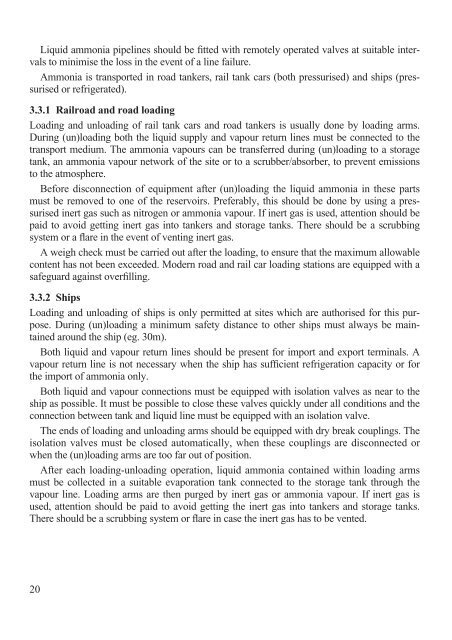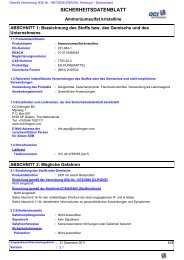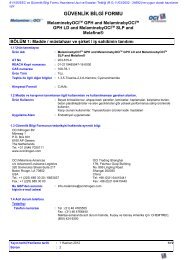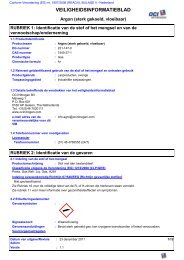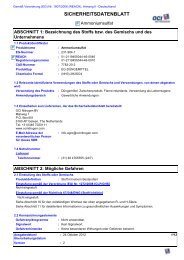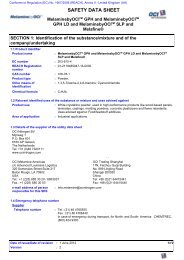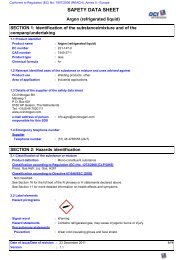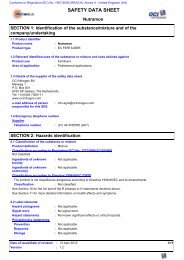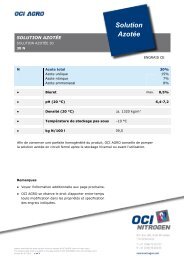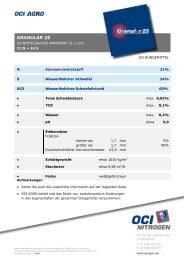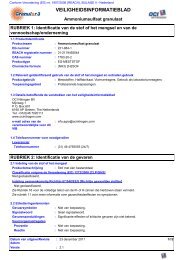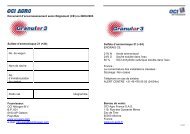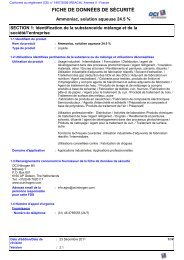PRODUCTION OF AMMONIA - OCI Nitrogen
PRODUCTION OF AMMONIA - OCI Nitrogen
PRODUCTION OF AMMONIA - OCI Nitrogen
You also want an ePaper? Increase the reach of your titles
YUMPU automatically turns print PDFs into web optimized ePapers that Google loves.
Liquid ammonia pipelines should be fitted with remotely operated valves at suitable intervals<br />
to minimise the loss in the event of a line failure.<br />
Ammonia is transported in road tankers, rail tank cars (both pressurised) and ships (pressurised<br />
or refrigerated).<br />
3.3.1 Railroad and road loading<br />
Loading and unloading of rail tank cars and road tankers is usually done by loading arms.<br />
During (un)loading both the liquid supply and vapour return lines must be connected to the<br />
transport medium. The ammonia vapours can be transferred during (un)loading to a storage<br />
tank, an ammonia vapour network of the site or to a scrubber/absorber, to prevent emissions<br />
to the atmosphere.<br />
Before disconnection of equipment after (un)loading the liquid ammonia in these parts<br />
must be removed to one of the reservoirs. Preferably, this should be done by using a pressurised<br />
inert gas such as nitrogen or ammonia vapour. If inert gas is used, attention should be<br />
paid to avoid getting inert gas into tankers and storage tanks. There should be a scrubbing<br />
system or a flare in the event of venting inert gas.<br />
A weigh check must be carried out after the loading, to ensure that the maximum allowable<br />
content has not been exceeded. Modern road and rail car loading stations are equipped with a<br />
safeguard against overfilling.<br />
3.3.2 Ships<br />
Loading and unloading of ships is only permitted at sites which are authorised for this purpose.<br />
During (un)loading a minimum safety distance to other ships must always be maintained<br />
around the ship (eg. 30m).<br />
Both liquid and vapour return lines should be present for import and export terminals. A<br />
vapour return line is not necessary when the ship has sufficient refrigeration capacity or for<br />
the import of ammonia only.<br />
Both liquid and vapour connections must be equipped with isolation valves as near to the<br />
ship as possible. It must be possible to close these valves quickly under all conditions and the<br />
connection between tank and liquid line must be equipped with an isolation valve.<br />
The ends of loading and unloading arms should be equipped with dry break couplings. The<br />
isolation valves must be closed automatically, when these couplings are disconnected or<br />
when the (un)loading arms are too far out of position.<br />
After each loading-unloading operation, liquid ammonia contained within loading arms<br />
must be collected in a suitable evaporation tank connected to the storage tank through the<br />
vapour line. Loading arms are then purged by inert gas or ammonia vapour. If inert gas is<br />
used, attention should be paid to avoid getting the inert gas into tankers and storage tanks.<br />
There should be a scrubbing system or flare in case the inert gas has to be vented.<br />
20


